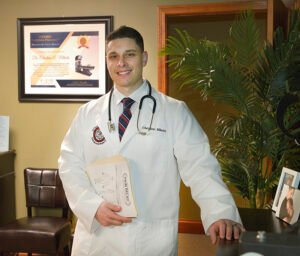U.S. Pain Foundation: 50 million Americans live with long-term pain that ranges from distracting to disabling
By Jane Schmitt
Pain management is a critical part of the local healthcare scene and that’s welcome news to people with chronic conditions affecting them not only physically but psychologically, too.

It’s time to get your life back, said chiropractor Christian Milioto of the Western New York Pain Relief & Integrative Wellness Center.
“People are looking for hope,” he said. “They’re looking for help.”
Milioto and other practitioners seek to provide some relief for pain-weary individuals who want to feel better and improve their quality of life. That’s no easy task, but this region offers lots of resources in the form of freestanding wellness clinics, rehabilitation facilities, therapy practices and specialty divisions of hospitals and health systems.
Pain is your body’s way of telling you that something is wrong, most likely due to injury, illness or disease. Pain that doesn’t go away over time or with treatment is classified as chronic and can lead to fear, anxiety, depression, limited mobility, lost independence, reduced productivity and feelings of isolation.
An estimated 50 million Americans live with long-term pain that ranges from distracting to disabling, according to the nonprofit U.S. Pain Foundation.
“When painful symptoms first arise, patients and their healthcare providers work together to see if they can identify and address the underlying cause,” the foundation says on its website. “For many conditions and injuries, however, there is no precise medical or surgical cure. As time passes, in addition to other diagnoses or even without an identifiable cause, patients may be diagnosed with chronic pain. Treatment goals will then shift from resolving the pain to reducing and managing it.”
One size doesn’t fit all
Americans spend billions of dollars a year on pain-relief treatments and care including medication, injections, therapy and exercise. The treatment approach is never one-size-fits-all and often is multidisciplinary, according to Cathy Hoy-Patterson, public health educator for the Niagara County Department of Health.
“You have to find what works best for you,” she said.
This spring, the department’s nursing division and the county Office for the Aging offered a free chronic pain self-management workshop at the North Tonawanda Public Library. The six-week program outlined a so-called toolbox, including cognitive behavioral therapy, to boost self-efficacy for people struggling with the physical and emotional impact of pain.
“We explain to people that they go to their doctor and (generally) spend 15 minutes with that doctor every couple of weeks. But they have 24/7, the rest of their lives, to manage their condition,” Hoy-Patterson said. “So let’s find some tools that work best for them.”
She added: “This workshop is not focused on medication; we do not prescribe anything. The philosophy is to increase self-efficacy.”
Developing communication skills is an important component.
“Often people are frustrated and they’re in pain and don’t how to communicate with their doctor and family members,” she said. “We can help them with that.”
Quality of life
Experts note that effective pain management doesn’t necessarily mean eliminating all the aches and hurts. Oftentimes it’s about gaining an increased understanding of what’s going on in the body and achieving quality of life despite the pain.
At the Western New York Pain Relief & Integrative Wellness Center, Milioto focuses on treating senior citizens whose struggles include neuropathy, herniated discs, spinal stenosis and pinched nerves. His work is inspired by his grandmother, who has dealt with rheumatoid arthritis, stenosis and osteoporosis.
Treatments offered at the center in Cheektowaga include spinal decompression, therapeutic laser, infrared light therapy, electroanalgesia therapy, chiropractic, hydromassage and whole-body vibration.
“I love what I do. There’s never been a day where I walked into my clinic and wasn’t excited,” Milioto said. “It’s helping people to get their lives back, but doing it safely, naturally and effectively.”
Chronic Pain
Common culprits include:
•Autoimmune disorders (i.e., arthritis, fibromyalgia)
• Traumatic injury
• Lasting pain from surgical procedures
• Cancer
• Neuropathy

